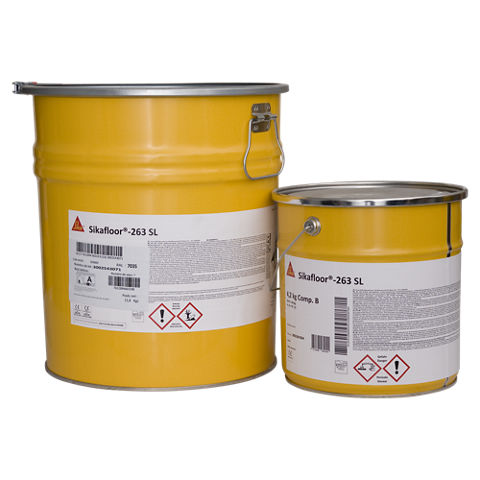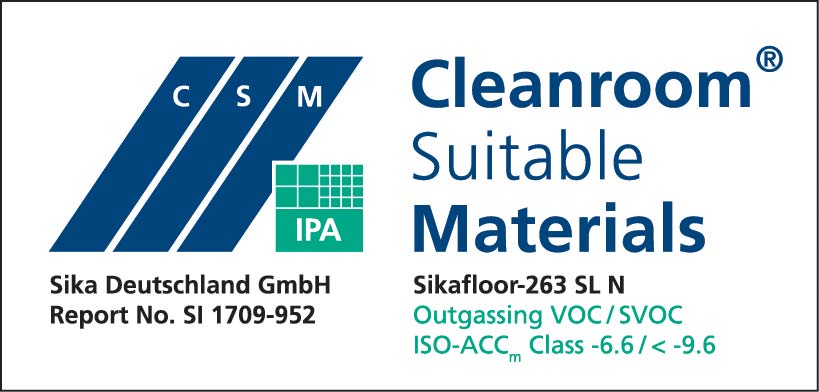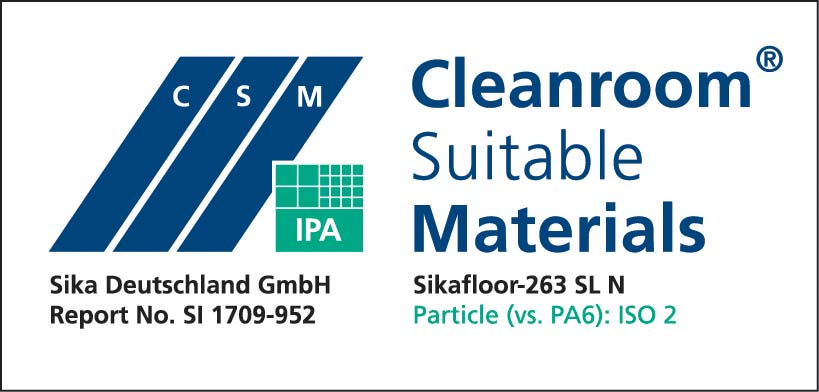
Sikafloor®-263 SL N
2-part epoxy self-smoothing resin floor finish
Sikafloor®-263 SL N is a 2-part epoxy coloured resin that can provide a hard wearing, seamless, low maintenance, smooth gloss finish or slip resistant finish when broadcast with different aggregate grades. Varying thickness’s can be achieved from 1,5–4,0 mm. For medium - heavy wear conditions. Internal use.
- Seamless and hygienic
- Filled with aggregate for economical and heavy duty resin screeds
- Good chemical and mechanical resistance
- Easy application
- Waterproof
- Gloss finish
- Slip resistant surface to suit clients requirements
- Low maintenance
Usage
- Self-smoothing system on concrete and cementitious screeds with normal up to medium heavy wear e.g. clean rooms, storage and assembly halls, maintenance workshops, garages, loading ramps etc.
- Slip resistant broadcast system for multi-storey and underground car park decks, maintenance hangars and for wet process areas, e.g. beverage and food industry
Advantages
- Seamless and hygienic
- Filled with aggregate for economical and heavy duty resin screeds
- Good chemical and mechanical resistance
- Easy application
- Waterproof
- Gloss finish
- Slip resistant surface to suit clients requirements
- Low maintenance
Packaging
| Part A | 15,8 kg containers |
| Part B | 4,2 kg containers |
| Part A+B | 20 kg ready to mix units |
| Part A | 220 kg drums |
| Part B | 177 kg, 59 kg drums |
| Part A+B | 1 drum part A (220 kg) + 1 drum part B (59 kg) = 279 kg 3 drums part A (220 kg) + 1 drum part B (177 kg) =837 kg |
Colour
| Resin - part A | coloured, liquid |
| Hardener - part B | transparent, liquid |
RAL 1001, 6021, 7030, 7032, 7035, 7037, 7038, 7040, 7042, 9002
Other colours on request.
Under direct sun light there may be some discolouration and colour variation; this has no influence on the function and performance of the coating.
Product Details
ENVIRONMENTAL INFORMATION
- Conformity with LEED v2009 IEQc 4.2: Low-Emitting Materials - Paints and Coatings
APPROVALS / STANDARDS
- Particle emission ISO 14644-1, CSM Statement of Qualification – class 2, Fraunhofer IPA Report No. SI 1709-952
- Outgassing behavior ISO 14644-8, CSM Statement of Qualification – class 6,6, Fraunhofer IPA Report No. SI 1709-952
- Reaction to fire classification according to EN 13501-1, Report-No KB-Hoch-171321-2, class Bfl-s1, Hoch Fladungen,Germany, January 2018
- CE-marking and Declaration of Performance as Coating for surface protection of concrete according to EN 1504-2:2004, based on certificate of factory production control issued by notified factory production control certification body and type testing.
- CE-marking and Declaration of Performance as Synthetic resin screed material according to EN 13813:2002, based on type testing and factory production control


Chemical Base
Epoxy
Shelf Life
24 months from date of production
Storage Conditions
The product must be stored in original, unopened and undamaged sealed packaging in dry conditions at temperatures between +5 °C and +30 °C. Always refer to packaging.
Density
| Part A | ~ 1,50 kg/l |
| Part B | ~ 1,00 kg/l |
| Mixed resin | ~ 1,44 kg/l |
| Filled resin ( 1:1) | ~ 1,84 kg/l |
All Density values at +23 °C.
Solid content by weight
~100 %
Total solid epoxy composition acc. to the test method Deutsche Bauchemie e.V. (German Association for construction chemicals)
Solid content by volume
~100 %
Shore D Hardness
| ~76 (7 days / +23 °C) | (DIN 53 505) |
Abrasion Resistance
| ~35 mg (CS 10/1000/1000) (7 days / +23 °C) | (DIN 53 109) |
Compressive Strength
| ~50 N/mm2 (Resin filled 1:0,9 with F34 / 28 days / +23 °C) | (EN196-1) |
Flexural Strength
| ~20 N/mm2 (Resin filled 1:0,9 with F34 / 28 days / +23 °C) | (EN 196-1) |
Tensile Adhesion Strength
| > 1,5 N/mm² (failure in concrete) | (ISO 4624) |
Chemical Resistance
Resistant to many chemicals. Contact Sika Technical Service for specific information.
Thermal Resistance
| Exposure* | Dry heat |
| Permanent | +50 °C |
| Short-term max. 7 d | +80 °C |
| Short-term max. 12 h | +100 °C |
Short-term moist/wet heat* up to +80 °C where exposure is only occasional (steam cleaning etc.).
*No simultaneous chemical and mechanical exposure and only in combination with Sikafloor® systems as a broadcast system with approx. 3 - 4 mm thickness.
Application
Mixing Ratio
Part A : part B = 79 : 21 (by weight)
Ambient Air Temperature
+10 °C min. / +30 °C max.
Relative Air Humidity
80 % r.h. max.
Dew Point
Beware of condensation!
The substrate and uncured floor must be at least 3 °C above dew point to reduce the risk of condensation or blooming on the floor finish. Note: Low temperatures and high humidity conditions increase the probability of blooming.
Substrate Temperature
+10 °C min. / +30 °C max.
Substrate Moisture Content
≤ 4 % pbw
Test method: Sika®-Tramex meter, CM-measurement or Oven-dry-method.
No rising moisture according to ASTM (Polyethylene-sheet).
Pot Life
| Temperature | Time |
| +10 °C | ~60 minutes |
| +20 °C | ~30 minutes |
| +30 °C | ~15minutes |
Curing Time
Before overcoating Sikafloor®-263 SL N allow:
| Substrate temperature | Minimum | Maximum |
| +10 °C | 30 hours | 3 days |
| +20 °C | 24 hours | 2 days |
| +30 °C | 16 hours | 1 day |
Times are approximate and will be affected by changing ambient conditions particularly temperature and relative humidity.
Applied Product Ready for Use
| Temperature | Foot traffic | Light traffic | Full cure |
| +10 °C | ~72 hours | ~6 days | ~10 days |
| +20 °C | ~24 hours | ~4 days | ~7 days |
| +30 °C | ~18 hours | ~2 days | ~5 days |
Consumption
~0,9–1,2 kg/m²/mm
These figures are theoretical and do not allow for any additional material due to surface porosity, surface profile, variations in level or wastage etc. For detailed information, refer to the system data sheets Sikafloor® Multidur ES-20 and Sikafloor® Multidur EB-27
MIXING
Prior to mixing, stir part A mechanically. When all of part B has been added to part A, mix continuously for 3 minutes until a uniform mix has been achieved. When parts A and B have been mixed, add the quartz sand and if required Extender T. Mix for a further 2 minutes until a uniform mix has been achieved. To ensure thorough mixing, pour materials into another container and mix again to achieve a smooth consistent mix. Over mixing must be avoided to minimise air entrainment.
Mixing Tools
Sikafloor®-263 SL N must be thoroughly mixed using low speed equipment (300 - 400 rpm). Use a forced action mixer of rotating pan, paddle or trough type. Free fall mixers should not be used.
APPLICATION
Strictly follow installation procedures as defined in method statements, application manuals and working instructions which must always be adjusted to the actual site conditions.
Prior to application, confirm substrate moisture content, relative air humidity and dew point. If > 4% pbw moisture content, Sikafloor® EpoCem® may be applied as a T.M.B. (temporary moisture barrier) system.
Primer:Ensure a continuous, pore free coat covers the substrate. If necessary, apply two priming coats. Apply Sikafloor®-156 / 161 /-160 by brush, roller or squeegee.
Preferred application is by using a squeegee and then back rolling in two directions at right angles to each other.
Levelling:
Rough surfaces need to be levelled first using Sikafloor®-156/-161/-160 levelling mortar (see PDS).
Self -Smoothing Finish:
Sikafloor®-263 SL N is poured and spread evenly using a suitable trowel/pin rake to the required thickness.
Spike roller immediately in two directions at right angles to each other to remove trowel marks, aid air release, ensure an even thickness and obtain required surface finish.
Slip Resistant Broadcast Finish:
Sikafloor®-263 SL N is poured and spread evenly using a suitable trowel/pin rake to the required thickness.
Spike roller immediately in two directions at right angles to each other to aid air release and ensure an even thickness. After about 15 minutes (at +20°C) but before 30 minutes (at +20°C), broadcast with quartz sand, at first lightly and then to excess to produce an even distribution surface profile. Allow Sikafloor®-263 SL N to initially cure and remove all loose sand by vacuum equipment. Apply a final seal/top coat of Sikafloor®-263 SL N by roller or squeegee at a consumption of 0.6 - 0.8 kg/m2 to completely encapsulate the sand. Then back roller in two directions at right angles to each other.
CLEANING OF TOOLS
Clean all tools and application equipment with Thinner C immediately after use. Hardened and/or cured material can only be removed mechanically.
